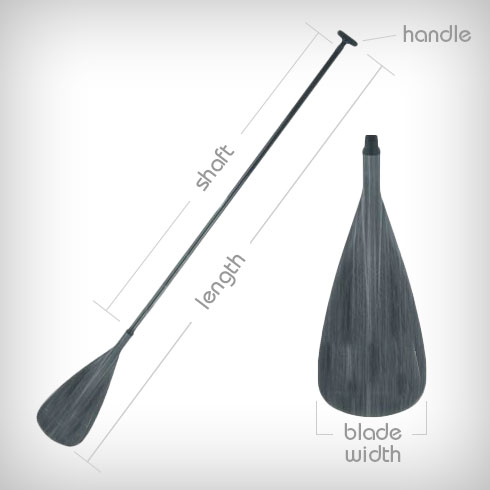Using the right paddle is important to maximizing your stand up paddle experience. This guide will help breakdown the different aspects that go in to making a stand up paddle what it is and point you in the right direction to find a paddle that best fits the type of SUP you want to do.
cadence
Paddle cadence will be referred to several times in this guide. This is just a fancy word for how many paddle strokes you execute in a given period of time.
- Low Cadence: Less strokes so this is usually a recreational paddler or well conditioned one who likes power that the start of each stroke.
- High Cadence: This means more incremental strokes. You will often see this with racers. A high stroke count will give quicker acceleration.
size
There are some general rules of thumb to follow when deciding on the lenght of your paddle.
- Racing, Touring or High Cadence Paddling: Add 8-10 inches to your height.
- Surfing or Low Cadence Paddling: Add 6-8 inches to your height.
Keep in mind that a little bit of personal preference goes into this but these are simply general rules. If you have the option to try an adjustable first it will allow you to try a few different lengths before deciding on a paddle and cutting it.
- 1 Piece or uncut: This type of paddle will be measured and cut for your size. The handle is then attached using epoxy. It is a great choice for durability and the lightest weight. Down side is if you will be sharing the paddle with others.
- 2 Piece Adjustable: These paddles have the ability to shorten or lengthen depending on the user. There is a locking device that allows you to lock it into the size for the current user. These paddles are great for families or people who will be sharing their paddle.
- 3 Piece Adjustable: This is just like the adjustable only it breaks down into three pieces. this the ultimate for travel and storage.
weight
SUP paddles are made from many different materials and this can drastically change the weight of a paddle. This will be important depending on what type of stand up paddling you will be doing.
For recreational paddlers who are out there for a short amount of time it is not has important. If you are racing or paddling for extended periods of time the heavier paddles can cause fatigue pretty quickly. Here is a list of materials from heaviest to lightest:
- Wood
- Aluminum
- Fiberglass
- Carbon Fiber
shaft material
The shaft of a paddle can come in different materials and shapes. Here is a breakdown of the different shaft materials:
- Aluminum: Cost effective but heavy. Good for families with kids or people spending short amounts of time on the water. Extremely durable.
- Fiberglass: These are lighter than the aluminum but are slightly more expensive.
- Hybrids: This will usually involving weaving two materials together. The most common combinations are carbon fiber and fiber glass or carbon and kevlar. This is done to keep cost down and still have a strong light paddle.
- Carbon Fiber: Generally the most expensive paddle but the lightest and strongest option. Carbon Fiber will be your best option racing or high cadence paddling.
Some of the shafts will come with a foam flotation device on it. This will prevent the heavier paddles from sinking if they are dropped in the water.
Companies have also started going beyond the standard straight shaft. Straight or bent both have benefits.
- Straight Shaft: More traditional, lighter, less expensive.
- Bent Shaft: Helps alight the wrist which will reduce strain and fatigue. It also allows you to reach further for more power with each stroke.
blade material
Like shafts, blades can be made out of different materials that will vary in weight and durability.
- Plastic: These will most commonly be seen on aluminum paddles. The blades are very durable but on the heavier side of the weight spectrum.
- Fiberglass: This helps reduce weight while still being a durable material. A good option for any beginner t0 advanced recreational paddler.
- Bamboo: Known for having an extremely high strength to weight ratio. This allows the blade to be light and strong. It gives the blade a nice natural look.
- Carbon Fiber: These will be your lightest option. Most popular for racers, high cadence or endurance paddlers.
blade width
As stand up paddling has grown over the years the gear has progressed along with it. Now many brands will offer wider or narrower blades. Here is what to consider when deciding for yourself:
- Wide: Used by paddlers who have lower cadence paddles. These provide a stable feel with greater resistance to each stroke. These are often used by most recreational paddlers. They are also used by paddlers who are very well conditioned that want the power and resistance and the start of their stroke.
- Narrow: High cadence paddlers often prefer a longer and narrower blade shape. This allows for higher repetition of strokes. It also gives you the option of using the blade tip for quick acceleration strokes or the entire blade for more bite. This type of blade can also reduce stress on the body if you are just using the tip of the blade.
